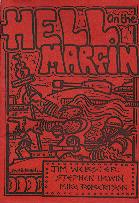| Brief Description | "Reasonably generic" set of science fiction
rules for games representing approximately divisional forces, playable in an evening. Intended to let players view
the "big picture" rather than get bogged down in low-level detail.
Stands represent companies, and are organized
into groups of any size. Players design each base's abilities by spending points for a combination of
properties:
- movement (foot, cavalry, vehicle, mecha, sub-flight [speeder bike], and flying),
- armour (light, heavy),
- weapon types (anti-infantry,
anti-armour, artillery) and range (long or short),
- quality (green, normal, veteran),
- and special abilities(electronic
counter-measures, nuclear-biological-chemical [NBC] weapons, transports, engineering, fuel for flight)
High-point-cost bases represent
leviathans (ground) or flying battleships (air). Certain movement and quality choices limit the
number of powers or point cost of stands. Ground vehicles can be tanks (turreted weapons) or assault guns (fixed
weapons). Planes can specialize in ground attack or air superiority. Rules also cover ground installations and
minefields.
Players place numbered counters face-down next to groups of units, then dice for Command Points to see
which and how many groups can take actions this turn. Players then alternate phases, making moves with one group per
phase; a group can both move and fight in each phase. A group can take several actions per turn if multiple counters
are allocated.
Ground and sub-flight movement is modified by terrain (open, built-up, rough, wooded); sub-flight vehicles can also
"pop up" to fight ground-attack aircraft. Planes can go off-table in order to refuel.
When combat is resolved, the phasing group gets to fire, as well as all groups which the phasing group is attacking
in the current phase. Stands can either participate directly in an attack, or act to support an attack. Limits apply
to the number and ability of units to "gang up" on a single target, and to support an attack. The effective range of a weapon varies
depending upon the armour of its targets. One die is rolled per
direct attacker, modified by armour, the defender's terrain, the number of supporters, troop quality, and various tactical
factors.
There are two special forms of combat: artillery and ECM. Artillery can act as support
during normal combat, or can attack on its own prior to normal combat resolution. Artillery units which have been
given "NBC offense" can fire NBC missions, which receive a bonus against units that do not have "NBC defense."
Units with ECM ability can initiate ECM combat prior to normal combat. A group which is defeated at ECM suffers combat
penalties.
As a result of combat, units become disrupted or destroyed. A disrupted stand suffers a penalty when attacking,
and can neither offer nor accept support in combat. Losses may cause an entire group to become disrupted, in which
case its support bases became ineffective and vulnerable, and the group might make an involuntary withdrawal.
Brief backgrounds and army suggestions are provided for the Republic (a dominant interstellar power), the Lords
of Mortification (feudal aristocracy using Mecha), the Pods (semi-vegetable aliens), and the Nasoid (methane-breathing
aliens).
|
|---|

